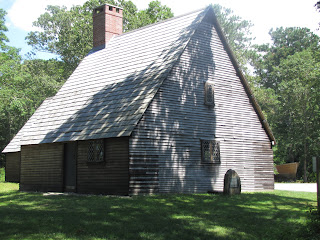 |
| Jonathan Bourne Histrical Center Summer 2012 |
The Jonathan Bourne Historical Center is located on 30 Keene Street, in Bourne Ma. The Center itself was built in 1897 by Emily Howland Bourne, who is a descendant of the prolific and regionally important Richard Bourne.
I have written about Richard Bourne several times now, as he was one of the first Christian missionaries to the local Wampanoag tribe and is also connected to the Wampanoag Indian Museum through one of his descendants.
The Historical Center building originally served as a town library. Emily Bourne had the library built in honor of her father, Jonathan Bourne. Jonathan, though a prominent resident of New Bedford at the time, was instrumental in helping the residents of Bourne achieve separation from the town of Sandwich in 1884. Because of his assistance, the new town was named after Jonathan Bourne and the Bourne family.
 |
| Bust of Jonathan Bourne at the Historical Center |
The building also houses many interesting exhibits. Among the most famous is the mysterious Bourne Stone, which I will be researching for a post in the very near future. However, their largest and most current exhibit is a display containing posters and artifacts from both the First and Second World Wars.
 |
| WWI and WWII Posters and Artifacts |
 |
| Stubby the War Dog |
 |
| Jolly Jane's Exhibit |
 |
| Aptuxet Trading Post Museum |
I had a great time visiting the Bourne Historical Center and the Aptuxet Trading Pos Museum.. Not only did I once again visit a museum dedicated to local history, but I learned several new things and was inspired to continue learning about what I saw. To me, that’s what its all about. As I’ve said, during the next few weeks, I hope to continue researching the Bourne Stone, Jolly Jane, and Stubby the war dog in order to create detailed posts about each.
Until then, if you are in the area, take time to visit the Jonathon Bourne Historical Center for yourself. It’s a great opportunity to admire objects and exhibits dedicated to some of the odder, more mysterious, and less well known subjects within New England History. In addition, it is a great example of how important smaller local museums are to the continued effort to preserve an archive our Yankee heritage for posterity.



